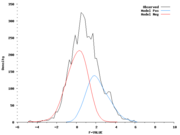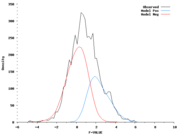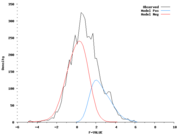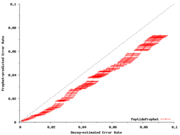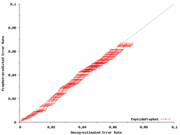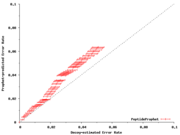TPP:Frequently Asked Questions
From SPCTools
TPP Frequently Asked Questions
What is CLEVEL and when do I use it?
- CLEVEL allows the user to manually control the region of f-values the TRUE distribution is allowed to cover
- CLEVEL is expressed in number of standard deviations from the mean of the FALSE distibution (default is 0)
- Negative CLEVEL is allowed and lets the TRUE and FALSE distributions overlap more
- The higher the CLEVEL the less overlap between the TRUE and FALSE distributions
- Use CLEVEL when the data is misbehaving and PeptideProphet model is under-predicting the error when compared to the DECOYS
- Use CLEVEL when the Mixture Model is not very well separated
What is the current version of the TPP?
The current version is 4.8.0, released November, 2014.
What operating systems are supported?
Linux and Windows. The Linux codebase compiles without changes on Mac OSX, but we do not officially support that platform.
What level of computer expertise is required to use the software?
Installation of the Linux version requires the ability to interact with the shell, compile software from source code, possibly install required software, and install and configure a webserver. The TPP GUI can be run in both Linux and Windows installations, and greatly reduces the complexity of of using the software.
Do I need to run the TPP GUI in order to use the software?
No, all of the TPP can be accessed from the command line (linux or Cygwin shell), and thus can be scripted as desired. Note that many of the programs have many options, and using the GUI might be an easier route for a new user.
Do you provide Linux binaries?
No, only source code is provided.
Do you provide Windows binaries?
Yes. We provide a native windows installation that includes a preconfigured webserver.
Does the TPP run on Windows?
Yes. We provide an installer native Windows installation, as well as the Apache webserver.
Do I need to download the TPP_Cygwin_Setup.exe program every time I install?
No. You can use the same installer program, which will look for the latest version via the internet.
How do I interact with data from the TPP?
Data is generally expected to be viewed from within a web browser. For linux systems, we recommend installing the Apache webserver (instructions here-- !add this). On Windows, our Cygwin installation includes the Apache server, which will be automatically configured by the installer.
What webserver configuration is required?
Linux: please see (!add this). Windows: none is required, as the installer automatically sets up Apache on port 1441.
Will the automatically installed Apache installation conflict with other webservers running on my Windows system?
No. The webserver is installed to run on port 1441, which is not used by any typically installed software. TPP-related webpages will be accessed by http://localhost:1441/..., rather than http://localhost/... .
How do I log into the TPP GUI?
After a sucessful installation, you should be able to point your broswer to http://localhost:1441/tpp-bin/tpp_gui.pl
You should be able to use the default username password combination of username "guest" and password "guest".
How do I move my data files?
There is no automatic way to do this, yet. You can run a sed command (!add example) to rewrite referenced paths.
At ISB, Abhishek Pratap has written a script to rewrite referenced paths and released it on September 4, 2008. ISB employees and others with access to ISB's computer network can find it at /sbeams/bin/updateAllPaths.pl. Copy it into the directory where you've moved your data files, then:
- $ ./updateAllPaths.pl *.xml *.shtml *.xsl
According to Abhi, "the current path will replace all the old paths except dbase".
Where can I go for help?
We have a very active newsgroup, spctools-discuss, hosted on google groups at http://groups.google.com/group/spctools-discuss . All TPP users are highly encouraged to subscribe, search the archives, and post their questions here for assitance from the TPP users community and / or the SPC software developers.
Additionally, all TPP users are highly encouraged to subscribe to the low-volume list spctools-announce, at http://groups.google.com/group/spctools-announce , for important announcements of bug fixes and improvements.
How do I upload files to the SPC tools team?
Occasionally, in a discussion on spctools-discuss, we ask newgroup members to upload files to our ftp site so we can debug issues. The site is at
ftp://ftp.systemsbiology.net/pub/incoming/
and is publicly accessible through any standard ftp client. Please note that you will not see your file after uploading it; this is normal. Please either post to the newsgroup or email us directly with the filename so we know where to find it!
How are the TPP releases named?
The versions are named according to various weather patterns.
How should I cite the TPP in my manuscript?
A recent publication you can cite is: Proteomics. 2010 Mar;10(6):1150-9. A guided tour of the Trans-Proteomic Pipeline. Deutsch EW, Mendoza L, Shteynberg D, Farrah T, Lam H, Tasman N, Sun Z, Nilsson E, Pratt B, Prazen B, Eng JK, Martin DB, Nesvizhskii AI, Aebersold R. PMID 20101611
The original paper is this (but the TPP has changed a lot since this paper): Mol Syst Biol. 2005;1:2005.0017. Epub 2005 Aug 2. A uniform proteomics MS/MS analysis platform utilizing open XML file formats. Keller A, Eng J, Zhang N, Li XJ, Aebersold R. PMID 16729052
